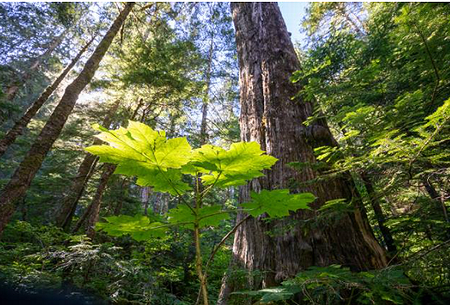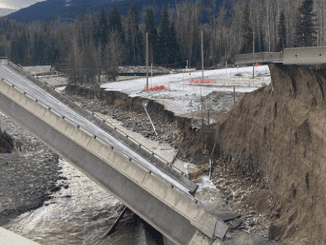
PORT RENFREW, British Columbia, Canada, September 14, 2021 (ENS) – The battle over protest blockades raised on southwestern Vancouver Island to prevent logging of some of Canada’s largest old-growth trees is headed back to the British Columbia Supreme Court this week.
Several days of hearings are scheduled in Nanaimo on Vancouver Island as Surrey-based logging company Teal-Jones seeks to extend an injunction order against protesters in the Fairy Creek area near Port Renfrew on the southwestern side of Vancouver Island. The Fairy Creek watershed is part of Tree Farm Licence 46, a 59,000-hectare timber harvesting tenure held by Teal-Jones.
The injunction is set to expire later this month, four months after police enforcement began and more than a year after the first blockades.
Fairy Creek is the last unlogged old-growth valley on southern Vancouver Island outside of parks, located northeast of Port Renfrew in the territory of the Pacheedaht First Nation.
Campaigners with the Ancient Forest Alliance have identified and documented massive yellow cedar trees, which appear to be within a proposed cutblock. One of them measured 9.5 feet in diameter, making it wider than the ninth-widest yellow cedar in Canada, according to the BC Big Tree Registry. Logging company Teal-Jones has been blasting roads in to reach this area, resulting in independent protesters setting up a blockade, turning machines away.
Since August 2020, protesters have been blockading the logging roads near Fairy Creek to keep loggers at bay. Protesters lock their arms and legs together, a move called blobbing, to form a human chain that vehicles cannot pass. Police pried them apart to arrest them.
Today, the Fairy Creek arrest total approaches 1,000 over the past four months as police and protesters offer widely differing accounts of events surrounding the big trees.
The conflict has restarted a heated debate on whether or not there should be a moratorium on logging Canada’s old-growth forests.
In June, the BC Provincial Government decided to honor the request of the Pacheedaht, Ditidaht and Huu-ay-aht First Nations and deferred old-growth harvesting in the Fairy Creek watershed and central Walbran areas in their territories.

The deferrals protect all old growth in the Fairy Creek watershed and the central Walbran area – spanning over 2,000 hectares – for two years while the First Nations title holders build resource-stewardship plans for their lands.
BC Premier John Horgan said the deferral is consistent with government’s commitments to reconciliation and to protecting old-growth forests.
“Reconciliation with Indigenous peoples and protecting the environment are top priorities for our government. We believe they must go hand in hand,” said Premier Horgan. “That’s why we’re pleased to approve the request from three First Nations to defer old-growth logging on their territory, including in the Fairy Creek watershed.”
“The first step in protecting old growth must be respecting Indigenous peoples’ land-management rights in their territories,” the premier said.
In 2019, the provincial government committed to aligning its policies, legislation and actions with the United Nations Declaration on the Rights of Indigenous Peoples through the Declaration on the Rights of Indigenous Peoples Act.
In 2020, the government committed to adopting all 14 recommendations of the independent panel on old growth, beginning with the immediate deferral of nearly 200,000 hectares of old-growth forests. Government has committed to continued consultations with Indigenous peoples on further deferrals of old-growth forests.
“True reconciliation means meaningful partnerships, listening to Indigenous peoples and trusting their stewardship of their territories,” Minister of Forests, Lands, Natural Resource Operations and Rural Development Katrine Conroy said. “This is a step in the right direction, but we know there is more work to do. Our government is doing the hard, but necessary, work to build a plan that protects B.C.’s old growth forests for future generations.”
Provincial Promises of Protection Unkept
One year after the BC government shared its Old-Growth Strategic Review, OGSR, report and Premier Horgan committed to implementing all panel’s recommendations, three BC environmental groups – Ancient Forest Alliance, Sierra Club BC and Wilderness Committee – have released a Report Card assessing the province’s progress on their promise to protect old-growth forests.
The OGSR’s report, made public on September 11, 2020, called on the province to work with Indigenous governments to transform forest management within three years.
The OSGR recommended taking immediate action to protect at-risk old-growth forests and a paradigm-shift away from a focus on timber value and towards safeguarding biodiversity and the ecological integrity of all forests in BC.
This recommendation applies in the contested Fairy Creek watershed where a federally-endangered seabird, the marbled murrelet, has been seen hundreds of times this summer in the area where Teal-Jones has begun logging.
“The intact nature of the Fairy Creek watershed is unique in the southern Vancouver Island region and could provide significant refugia for nesting marbled murrelets in this area,” wildlife consultant Bernard Schroeder said in his July report to Sierra Club BC and Wilderness Committee.
Murrelets showed the most severe decline in areas that have the highest levels of old-growth forest removal, Schroeder found.
“When old-growth forests are destroyed for short-term economic profits we lose critical biodiversity habitat forever. BC is Canada’s most biodiverse province; sadly it is also home to the most species at risk and is one of only three provinces that lacks an endangered species law,” said Sierra Club BC’s Grants and Partnerships Manager Britton Jacob-Schram.
But old-growth-related headlines in recent months have been dominated by police violence and arrests of forest defenders, rather than protection.
As of this week, with nearly 1,000 arrests, the fight to save what remains is now Canada’s biggest act of civil disobedience.
“Premier Horgan’s failure to keep his promise has now fueled the largest act of civil disobedience in Canada’s history, larger than Clayoquot Sound, with no end in sight. People know that clearcutting the last old-growth is unforgivable,” said Jens Wieting, senior forest and climate campaigner at Sierra Club BC.
In their report card, the organizations issued new grades on the B.C. government’s progress in five key areas, crucial for implementation of the OGSR panel’s recommendations:
- – immediate action for at-risk forests (F)
- – the development of a three-year work plan with milestone dates (D)
- – progress on changing course and prioritizing ecosystem integrity and biodiversity (F)
- – funding for implementation, First Nations and forestry transition (D)
- – transparency and communication (F)
“The tough reality is that thousands of hectares of the endangered forests that Premier Horgan promised to save a year ago have been cut down since then,” said Torrance Coste, national campaign director for the Wilderness Committee. “We’ve seen pitifully little concrete action to protect threatened old-growth, and ecosystems and communities are paying the price for the BC NDP government’s heel-dragging.”

The Wilderness Committee is “deeply concerned about the excessive use of force against old-growth demonstrators on behalf of the RCMP,” said Coste, referring to images of the Royal Canadian Mounted Police caught on camera at the blockade sites.
“These images come just two weeks after Supreme Court Justice Douglas Thomson rebuked the RCMP’s use of sweeping restrictions and exclusion zones around the blockade areas as illegal,” Coste said. “The Wilderness Committee has long opposed the utilization of injunctions to block public access and cut off the ability of people to exercise their right to non-violent protest.”
In his ruling, Justice Thomson wrote, “I have found that the police actions interfere with important liberties of members of the public and members of the media. … These RCMP blockades are unlawful.”
Coste said, “There is conflict in the woods because of failed provincial government policy on old-growth and the province has a duty to address and rectify this, not offload the responsibility to quell public unrest onto the courts. We call on the RCMP to stand down and provide space for this situation to de-escalate safely.”
The RCMP tell a very different story. On September 9, the National Police Federation released a survey which shows that 82% of British Columbians agree that the RCMP have a duty to enforce Supreme Court injunctions. In addition, nearly 3-in-4 agree that the Pacheedaht First Nation request for protesters to leave their territory should be respected, even as 77% believe protest is an important part of democracy.”
The online survey of 800 British Columbia adults was conducted by Pollara Strategic Insights between August 30 and September 2, 2021.
Brian Sauvé, president of the National Police Federation, said, “Our Members have professionally and respectfully enforced a BC Supreme Court Injunction since mid-May. This has resulted in over 860 arrests for violation of the injunction over 114 days, with very few if any credible complaints, including one related to an incident involving force after a police officer suffered a concussion as a result of being pushed to the ground by a crowd of protestors.”
“The protestors are extremely and globally well-funded, many of whom are highly experienced in media manipulation and propaganda, and they have demonstrated that they are increasingly desperate to intimidate our officers and mislead the public in their ongoing campaign against both the licensed forester and the Pacheedaht and Ditidaht First Nations upon whose traditional territory they are imposing,” Sauvé said.
The environmental campaigners continue to blame the provincial government for failing to protect old-growth as Premier Horgan promised.
In July, the province created a technical expert panel to inform the next announcement of old-growth deferral areas. Repeated government remarks about new deferrals in the summer sparked a glimmer of hope for science-based interim protection for all at-risk old-growth forests in BC in the near future.
But as the summer draws to a close, no more deferrals have been announced and that hope is fading.
“In the last six months, the B.C. government has failed to allocate any funding toward protecting old-growth, instead funneling millions into police enforcement to clear a path for old-growth logging,” said Andrea Inness, forest campaigner for the Ancient Forest Alliance. “Without funding to support old-growth protection, the BC NDP government is forcing communities to make the impossible choice between revenue and conservation. They’re choosing inaction while the conflict in BC’s forests worsens.”
Ancient Forest Alliance, Sierra Club BC and the Wilderness Committee will continue to mobilize their tens of thousands of supporters and hold the government accountable for its old-growth promises. Their next report card will be issued on March 11, 2022.
Featured image: This satellite image of the Fairy Creek watershed shows how logging has already cleared the old-growth forest from the valleys surrounding Fairy Creek. 2021 (Photo courtesy Ancient Forest Alliance)



